With three national websites and a franchise based business model, Bristol based The HR Dept is really several campaigns rolled into one. After two years working with them, we have delivered an 80% year on year increase in goal conversions and numerous wins for their franchisees and we still have so much more to achieve for this market leader in HR services.
“We have been extremely pleased with the guidance and expert knowledge provided by Superb Digital. They are always quick to respond and very proactive in their approach. Since working with them for the last couple of years we have seen very positive results. Thank you Paul, Joe and the team.”
FELICITY KENNY, MANAGING DIRECTOR, THE HR DEPT
The HR Dept is a national franchise providing HR consultancy and related services for SMBs up and down the UK. Established in Bristol (where the head office still resides) in 2002 by Sue Tumelty, the company quickly grew into a franchise based business, with individual HR directors heading up their own territories across the UK, Ireland and Australia. These individual franchises are small companies in their own right, with many employing several support staff.
In November 2021, The HR Dept Group Ltd became an employee ownership trust.
The HR Dept’s brand presence consists of three websites: The HR Dept, The Health and Safety Dept and Franchise recruitment.
Unlike the first two, whose audiences are the end users, franchise recruitment targets HR professionals looking to set up their own HR consultancy business.
Having three websites to work on was a huge challenge, as each in itself is a huge project with different requirements and challenges.
Despite previous work with a number of Search Agencies, The HR Dept hadn’t received much strategic advice, as both the HR and HS Dept websites had little search visibility around most of their key services, some of which had huge traffic potential.
A major challenge identified from the outset was duplicate content. The company’s websites were set up to effectively host each franchisee territory on their website as a separate area of the main website. With over 60 active franchisees, this meant every single piece of content on the main site was replicated 60 times over.
This was just the tip of the iceberg in terms of the work that lay ahead. Other issues included no analytics or goal conversions set up, localisation issues, the sheer volume of rankable content topics to cover, not to mention the challenge of promoting the strategically vital HR recruitment side of the business, which has little to no search volume.
So with three websites to look at and a finite budget, we focused our energies on the HR and HS Dept sites first.

After dealing with duplicate content and other technical SEO challenges, the vast majority of the work would be centred around building out The HR Dept’s content. Whether that was localising franchisee areas of the site, improving existing service pages, or creating expert guides to supplement service pages, the issue was content. Or rather a lack of it.
Another element of the campaign was promoting the franchisee sections of the website. The HR Dept’s business model sees franchise fees go towards national marketing, but with many franchisees in highly competitive regions or cities, we hit on the idea of creating franchisee packages, to supplement this to any franchisees that wanted it. The take up was encouraging and we’ve seen some great successes with individual franchisees.
The franchise recruitment strategy has focused on developing the brand with content created through interviewing franchisees and senior personnel at head office. We have had great feedback so far but it’s early days and we look forward to working more closely with The HR Dept on this area in the coming months.
We have well and truly achieved great results for the HR Dept website, with an 80% increase in enquiries and 60% increase in organic traffic for The HR Dept site. HS Dept, which had far less SEO work done to it when we took this on it should be pointed out, has seen a massive 492% increase in organic traffic.
The localisation work we have done for the franchisee pages on the main HR Dept site, has also had a huge impact, with many of them coming from nowhere to rank in positions 1-3 for local HR related search terms in their area.
All of this has led to a surge in enquiries for The HR Dept’s franchisees, such as:
As we continue to grow topic clusters around key services, we expect The HR and HS Dept’s national search presence to continue its upward trajectory, with more business generated for their network of franchisees as a result.
At the same time, we are now turning our attention (and budget) towards really pushing the franchisee recruitment side of the business, in order to attract new franchisees to take on this growing demand.
Over the last year, mustard jobs have seen a surge in activity within the events industry across the UK. With Brexit, Covid and the Cost of Living Crisis significantly affecting the rate of movement within the industry in recent times. We’re breaking down the current trends, salary expectations, candidate availability and industry growth of the events sector.
At the beginning of the year we saw various external factors make candidates more hesitant about moving roles. Even though the cost of living remains high, the UK hasn’t plunged into a recession yet so candidates are maneuvering in the market again.
The events industry is booming across the UK, and Brand Experience within London remains a particularly busy sector for the mustard team for permanent and contract roles.
Covid-19 has become a memory of the past and as a result the Tradeshow Exhibition industry is back and better than ever. Virtual Broadcast has maintained popularity within the corporate space as streaming functionality is more accessible than ever. This has provided continued success for global brands looking to improve sustainability, reducing flights and event waste.
Whilst London still remains the hub of the event sector, other areas such as Manchester, Leeds and Bristol are seeing sharp growth, fueled by increased flexibility to work from home post pandemic. As a result, we’re seeing top talent move away from London.
Firstly, Sustainability. Eco washing has become a prevalent issue across the industry, with brands implying sustainability rather than working on making real positive change. As more candidates in the industry are looking to work within an actively sustainable organisation, being certified as B-Corp or part of an industry specific sustainability group such as Isla, will ignite candidate attraction.
Next up, Flexibility. As a lot of employees within the sector devote their weekends and evenings to meet the demand of the job, working the ‘allotted’ 9-5 are becoming increasingly difficult to adhere to whilst maintaining a work-life balance. As a result, there is increased pressure on employers to offer flexible hours to align with this.
The digital age has taken events to the next level. Consequently, employers are looking for event professionals with a mix of digital skills, the more digital integration the better. AR and VR offer interactivity that will engage audiences across the entire industry and showcasing any digital skills will give your CV the edge. This could include anything from working on virtual events, website registrations, video content, motion graphics, graphic design, animation and 360 photography.
Salaries have gone up drastically when comparing the mustard XP salary guide from 2021 to 2023. As an example, a Mid-weight 2D Designer working in London in 2021 would be earning around £28,000 – £36,000 but in 2023 they’re more likely £40,000 – £50,000.
This could be because a lot of candidates left industry during the Covid-19 lockdown period for job security elsewhere so there is smaller pool of candidates, as a result employers are battling for the top candidates, offering higher salaries to entice them into their role. As the industry has bounced back in full force the demand for skilled candidates has increased.
“The Experiential, Events and Exhibitions industries have fluctuated dramatically within my five years as a recruiter in this space. We’ve seen various highs and lows across the industry over the last few years, but now is such an exciting time to be expanding your business or to move into a new role.”
– Jamie Rogers, XP Divisional Lead at mustard jobs.
The transition from Universal Analytics to Google Analytics 4 is complete, marking the end of an era for businesses, marketers and data analysts worldwide. Following this change, it’s only right that we should question its capabilities.
What is Google’s next-generation data property really capable of? How will it change the ways in which we record and utilise data?
Most importantly, can it really predict the future?
Of the many innovative features present within GA4, its predictive capabilities and integrated machine learning algorithms are the most striking. In the right hands, these tools offer enriched data collection and advanced insights for businesses, though there are certain limitations.
Of course it’s important to remember that predicting the future is impossible, even for Google. That said, GA4’s machine learning algorithms and predictive analytics features bring us closer than ever. Using data collected from past user behaviour, the property is able to predict which customers are likely to convert, channels that will lead them there, and the devices they are most likely to browse from.
It is worth noting that these predictions are limited by both the accuracy and totality of the data from which they are drawing. In other words, the better quality the input you give GA4, the more accurate the output.
As it stands, GA4 is able to generate predictions based on three primary metrics: purchase probability, churn probability and predictive revenue.
This metric refers to the probability that a user who was active in the last 28 days will log a specific conversion event within the next 7 days.
As the name suggests, this metric refers to the probability that a user who was active on your app or site within the last 7 days and will not be active within the next 7 days.
Predicted revenue forecasts total revenue from all purchase conversions within the next 28 days from a user who was active in the last 28 days.
As touched upon earlier, future metrics are driven by predictive modelling. What this means, is that by training machine learning algorithms to respond to certain datasets, GA4 is able to forecast activity, behaviour and trends. This information can then be used to create predictive audiences.
In Google’s own words, a ‘predictive audience is an audience with at least one condition based on a predictive metric. For example, you could build an audience for ‘likely 7-day purchasers’ that includes users who are likely to make a purchase in the next 7 days.’
There are a multitude of scenarios in which predictive audiences can be used to enrich data and engage with potential customers, such as remarketing or re-engagement campaigns.
As is the case with all machine learning tools, a certain amount of pre-existing data must be collected in order to generate predictions.
Firstly, you’ll need to have at least 1000 positive and negative samples. In other words, GA4 requires data on at least 1000 purchasers or conversions (positive) and 1000 users who have not purchased (negative). Additionally, the number of non-operative or inactive users on your site must be at least 1000.
Moreover, GA4 requires the above mentioned model quality to be maintained for a certain amount of time. Usually, this is around 28 days. Audiences that do not meet these prerequisites will be deemed ‘not eligible to use’ until sufficient data is gathered.
For those working within data-driven marketing, predictive analytics exist as an opportunity to leverage insights and increase the effectiveness of your campaigns. Whether you’re looking to reduce churn rates, optimise campaign performance or ready yourself for the fast-approaching cookieless future, there are a plethora of ways in which businesses can use predictive analytics to their advantage.
Let’s be real, GA4 is by no means the finished article. Nor is it an omniscient force, here to transform the world of marketing and SEO forever. The property leaves plenty to be desired in terms of user experience and is certain to be refined over the coming months and years. The extent to which these refinements will impact its predictive capabilities is a matter of speculation, though it is safe to assume that they will only get better.
As a data driven SEO agency, we make it one of our primary missions to maintain a comprehensive and up to date understanding of Google’s latest analytics property. To this end, we possess the knowledge and experience required to leverage the full power of GA4’s cutting edge features, granting our clients valuable insights and actionable analytics that help us drive real conversions and sales.
We are so please to announce that we won three awards at the UK Agency Awards 2023, held in London on September 21.
We were named Best Large PPC Agency in the UK, and also won Innovative Agency of the Year and Best Campaign for our work to drive revenue for our lovely client, David Salisbury.
The UK Agency Awards celebrate the best agencies working across all verticals, from creativity and design to digital and technology, from marketing and advertising to public relations and media.
The judges praised Launch for its focus on our people; “It is great to see that this agency’s focus extends beyond just tracking performance, with a genuine emphasis on the happiness and well-being of employees, which is truly commendable, and it is clear to see the positive impact this has has on the agency and the results the team have achieved.”
Our fab founder, Jaye, was delighted with the awards; “Our mission is to be the happiest performance agency. I believe that happy people do great work, and by empowering our team to do their best, we can get great results for our clients. So, I am absolutely thrilled that as we enter the final quarter of the year the whole team is recognised for their hard work.”
User testing is analogous to asking your friends to try out a product you’ve produced, to put it simply. Consider creating a toy or game and wanting to determine whether it is enjoyable and simple to play. Similar user testing is done for websites and apps. People who didn’t build it check it out and report back on what works and what doesn’t. This makes it better and simpler for everyone to utilise websites and apps. London-based digital consultancy WeAgile will conduct user testing on your new website or app if you are one of our very fortunate and satisfied customers. Why not reach out to us right away to learn more? But now – onto User Testing.
To make user testing feasible and effective, you’ll need to take a number of actions. Here is a brief explanation of each of the steps; we will go into greater detail on some of them in the blog.
This could be a brand-new website, app, or other digital product created to address a particular user demand. The testing procedure is built upon this phase. Simply put, there won’t be anything to test without the product (even if it’s an MVP).
Based on your objectives, pick the testing approach that is best for you. (Read more about down below). Depending on the insights you want to gain, this may involve usability testing, A/B testing, or even eye-tracking experiments. Each approach presents a distinct viewpoint on user engagement and pleasure.
Find the people that most closely resemble your target market. You can be confident that the feedback you receive correctly represents the experiences and preferences of your real users by selecting participants who are representative of them. Trust us when we say it. Below, we go into further depth regarding several locations where you might discover your test subjects.
Select a suitable area to carry out the experiments. If you’re conducting online testing, this could be a controlled environment, a real-world scenario, or a remote environment. The setting ought to reflect the way users would naturally engage with your digital work. Most likely, the people who take part in your test will test your website or app from home, on their own schedule. Just always tell them when they have to turn in their results, so keep reading.
Find out how long it will take each participant to finish the test. By evaluating how long customers generally spend navigating through your digital product, you can make sure that the testing period is reasonable and doesn’t pressure participants.
Give the chosen participants access to your digital product and the essential instructions. Sharing a website or app’s link may be necessary for this. Consistent outcomes across participants are ensured by clear criteria.
Gather and assess the information and comments gathered during the testing process. This entails assessing user interactions, watching how they behave, and taking into account their input. To learn how consumers interact with your new app or website, look for patterns, insights, and pain areas.
Given that we discussed a variety of testing techniques in the preceding section, you may be asking how to do user testing for your product. There are various methods for conducting user testing because every product, prototype, and feature is unique — just like every firm. We’ll examine the three most popular ways WeAgile, a web design and development company in London, has had tremendous success with. There are various approaches that may be utilised for user testing.
In A/B testing, you split up your test subjects into groups (which could be two or more) and have them try out several iterations of your product to determine which they prefer. This enables you to determine whether version delivers your clients a better user experience and makes them happy. A/B testing involves exposing your clients (or test subjects) to various versions of your product. It’s comparable like testing various ice cream flavours to determine which one they prefer. You get to observe what actually excites your customers rather than assuming based on what you know about them. Even if you are confident in your knowledge of your clients, A/B testing may still surprise you and reveal something intriguing. There is a reason why huge companies (like Facebook) do A/B testing regularly.
It does sound a lot like user testing, don’t you think? It is not, however, the same. Before getting into the specifics, let’s first examine the distinction. The entire range of client interactions with your website or app is captured during user testing. This may include — from when they first come into contact with the object until when they cease using it, their thoughts, feelings, likes, dislikes, reactions, and behaviours related to the item. On the other hand, usability testing focuses on how and to what extent a client uses your product to accomplish a certain goal. Even if it helps to make the user experience as a whole, this isn’t the whole journey.
Giving a product, prototype, or feature to actual customers (or your test subjects) allows you to gauge how user-friendly it is. Usability is the ability of a product to be useful and simple to use. You can determine how naturally your actual users find your product, prototype, or feature by conducting usability testing.
Beta testing happens in the last stages of developing your website or app. It occurs when you present your finished product to your clients and target market and allow them to closely examine how it will look when it is ready for release. Prior to entering the market, this testing phase serves as the final customer approval.
When should beta testing be used? It’s ideal when you’re almost done creating your product and want to get one more opinion before releasing it to the public. This step gives you the chance to make any last-minute adjustments to the user experience, making sure it’s excellent for your clients. Other user tests throughout the design process ought to have been conducted before beginning the beta testing phase. This is so that only the most significant and final product upgrades are subjected to beta testing. By getting client feedback beforehand, you’ll probably only need small changes—if any—during beta testing. By using this tactical approach, you can be confident that your product is polished and prepared to shine.
A variety of measurements used in user testing are used to assess the usability and efficiency of your website or app. These metrics offer insights for improvement by quantifying user interactions, engagement, and satisfaction. Here are some metrics from user testing that you can find helpful for your website or app. Keep in mind, though, that not all of these will apply to your digital project because every website and app is different (in its own way). These metrics offer insightful data on how people interact with your websites and apps, assisting in the development of improvements and optimisations that will result in a flawless and pleasurable user experience.
Task Success Rate: this measures the percentage of tasks users successfully complete during testing, indicating how well your design supports their goals.
Time on Task: the time users spend on specific tasks. This could indicate how intuitive and efficient your design is.
Error Rate: this metric calculates the frequency of user errors during tasks, shedding light on confusing or challenging aspects of your product.
Click-Through Rate (CTR): for links or buttons, CTR measures user interaction by showing how often they click on these elements.
Bounce Rate: for websites, this measures the percentage of visitors who leave after viewing only one page, indicating a lack of engagement.
Navigation Flow: it maps users’ journey through your website or app, revealing any confusing pathways or friction points.
Satisfaction Ratings: these are often obtained through post-test surveys; these ratings provide insights into users’ overall satisfaction with the experience. You could also do short (or in-depth) interviews with the test participants if the time and resources allow.
Net Promoter Score (NPS): this measures users’ likelihood to recommend your website or app to others (be it their friends, family or promotion on social media channels). This reflects their overall satisfaction – the more satisfied they are, the more they will promote it – as simple as that.
Conversion Rate: for e-commerce sites, this measures the proportion of visitors who complete desired actions, such as making a purchase.
Scroll Depth: tracks how far users scroll down a page, showing if important content is being missed.
Time to Complete Tasks: it is what it says on the tin. This quantifies the time users/test participants need to finish tasks, revealing potential obstacles or ease of use.
User testing works like a detective, swiftly identifying the precise issue so that your team doesn’t spend time and resources on the wrong thing. It involves making a quick investment in the appropriate cause. Your product, feature, or prototype may be simple to use for your team and designers, but it could not be for your actual customers. User testing reveals areas in which your product might be more appropriate for your target market. It highlights the areas where people might become perplexed or irritated. Since user testing takes place prior to the release of your product, you can utilise this information to keep making improvements until you’ve created a user experience (UX) that you’re truly proud of.
To get insightful feedback on your digital products, you must enlist consumers to test them. If you’ve decided to attempt to do it on your own, here’s how and where to do it.
Your Network: Start by reaching out to friends, family, and colleagues who fit your target user profile. They can provide initial insights and help you refine your testing process.
Social Media: Post a call for participants on your social media accounts or in relevant groups. Explain what you’re looking for and the perks of participating (e.g. an Amazon voucher or a free subscription to your app once it launches). Platforms like Meta, LinkedIn, and X can be effective.
Online Communities: Participate in forums, discussion boards, or online communities related to your product’s niche. Engage with users, build rapport, and then invite them to test your product.
User Testing Platforms: Websites like UserTesting.com, Userlytics, and TryMata allow you to recruit users based on specific demographics. These platforms handle the recruitment process for you – easy but not always cheap. There are a couple of more you can have a look at – Helio.app (formerly Verifyapp.com), UXTweak.com.
Email Subscribers: If you have an email list, send out an invitation to your subscribers. They’re likely already interested in your product and might be willing to participate.
In-Person Events: Attend relevant meetups, conferences, or workshops. Engage with attendees and invite those who align with your target audience to participate in testing.
Universities: If applicable, approach universities and colleges to recruit students who match your user profile. Many students are open to participating in user testing.
Local Communities: Utilise local bulletin boards, community centres, or coffee shops to post recruitment flyers. This can help you find participants within your area.
Referrals: Ask your current participants if they know someone else who might be interested in testing your product. Referrals often lead to engaged participants.
Paid Advertisements: Consider running targeted online ads to reach your desired user demographic. Platforms like Facebook Ads and Google Ads can help you reach a wider audience.
User testing enables us to improve, innovate, and create digital solutions that genuinely resonate with our audience with every click, scroll, and interaction. By embracing the art and science of user testing, we not only produce useful products but also experiences that have a lasting impression on users and the digital world. Let us at WeAgile join you on this exploration as we work to improve customer satisfaction, elevate our design, and push the envelope of what is conceivable for websites and mobile applications.
Sometimes merely using words or static visuals to describe something is insufficient. Making a wireframe is the next stage once a concept for your company’s mobile app or website has taken shape. To guarantee that consumers have a flawless browsing experience, it nevertheless occasionally occurs on paper or via a dedicated tool. Interactive mockups known as prototypes are used to test the aesthetic and user experience of websites and mobile applications.
Designers and developers can demonstrate how they want something to look and function via interactive prototypes. They may test the interactions they want to use, which will aid developers in knowing what to design. Like a how-to manual for getting everything just right!
For both websites and mobile apps, an interactive prototype provides insights about user interaction at several levels. By allowing users to evaluate design usability and feasibility before to the start of the development phase, these prototypes help eliminate unforeseen problems that may arise during project execution. It acts as a sneak peek or presentation of the final look, navigation, drop-downs, and filtering capabilities of a digital product. Because of its robustness, users may thoroughly examine the system’s features, functionality, and usability in a single package. It is similar to taking a “test-drive” before buying “the car” (i.e., creating a digital product).
There are currently a lot of different options to choose from, despite the fact that it has long been a preferred pick for UX/UI design teams. Figma is used by almost four million people. It is excellent for project management, building website pages, making app prototypes, and brainstorming and mind maps. To see if it works for your needs, you can start with the free version.
Instead than being a single tool, InVision is more a collection of tools. Three tools and collaborative places are included in one membership. The first is Freehand, which is used for collaborative wireframing in real time. After that, you proceed to Studio to design screens and create interactive prototypes. Studio features a function that allows you to turn comment suggestions into tasks that can be completed. When everything is finished, use Inspect to collaborate with developers and give off designs.
This is an excellent tool for collaborating between designers and developers. After finishing your project on Webflow, you can download the HTML, CSS, and Javascript code (without really having to code anything). It will resemble something a developer would create exactly! Give your developer this code so you won’t have to worry about the front-end details any more.
Sketch provides a sizeable selection of prototyping tools. You may bring your ideas to life in ways that enhance the projects you’re working on by using tools like scrolling artboards, fixed elements, and overlays.
According to user feedback, Miro’s prototyping tool streamlines the prototyping process, making it efficient, flexible, and collaborative. Additionally handily, Miro provides wireframe and prototype templates. Over 60 million people presently use Miro, so there must be some value there. Check it out for yourself without a doubt!
Our team of designers, developers, and marketers at WeAgile, a digital agency based in the UK, has extensive experience in app development, website development, and digital marketing. Reach out to us right away and let’s start to work on your brand-new, exciting digital project or campaign!
Launched back in August 2022, with an update in December, the ‘helpful content update’ is the latest significant change to Google Search’s algorithm, with the company stating it would be prioritising content “written by people, for people.”
Sounds obvious, but the devil, as always, is in the detail.
Google acknowledges the power of SEO in elevating search visibility, but it has long been on the hunt for those websites who prioritise the algorithm over content that people are really looking for. The helpful content update seeks to address this perceived issue by rewarding websites that provide valuable, relevant content whilst penalising those that don’t.
The big question is, how does this all work in practice and what indicators is Google using to differentiate good helpful from unhelpful content
The helpful content update works through a site-wide signal that identifies content that provides little to no value or does not help users with their particular search queries. If a website is found to have relatively high amounts of such low-value, unhelpful content, it will perform worse in Google Search.
The process is completely automated, identifying content through a machine-learning model. It is neither a manual nor a spam action.
So what exactly does Google consider ‘unhelpful content’?
It’s a question that can be answered with a series of questions that you can ask yourself.
This is the line of questioning you should start with when examining your content to get an idea if it’s helpful or unhelpful by Google’s standards. The philosophy fuelling this approach goes back to serving “people first” when creating content, and actively avoiding the creation of content to game search engines.
People use search to look for content that’s relevant to their interests, useful for their inquiries, trustworthy in their eyes, and engaging to consume. People-first content offers all those elements.
When people are done consuming people-first content, they leave feeling satisfied. They have their questions answered, their curiosity sated, their trust gained or strengthened, and maybe even have their feelings stirred.
If your content is – for the most part – regurgitating what’s already been said without contributing original perspectives or analysis, then it’s in the firing line.
A common example of search engine-first content, that you yourself may have stumbled upon, is content that purports to answer a question but doesn’t. People will always be Googling questions like “when is the next iPhone coming out?”. Search-engine first content would typically present a 500-word article repeating that question in so many different ways only to say in the end that there’s no actual release date yet. Avoid creating this kind of content, as Google is no longer tolerating it with this update.
Google Search prioritises content that it deems most helpful to rise up the SERPs. Determining what’s ‘most helpful’ is based on how much content shows experience, expertise, authoritativeness, and trustworthiness (EEAT).
Helpful content doesn’t need to demonstrate all E-E-A-T qualities, but what does matter the most is that it shows enough of either experience, expertise, and authoritativeness that it becomes trustworthy.
A review of a smartphone where the content creator shows plenty of first-hand experience using the phone can still be helpful even if that content creator doesn’t have all the expertise to know how the underlying technology of the device works.
E-E-A-T matters even more when it comes to subject matter that concerns people’s financial stability and personal safety, and the welfare of society. News about natural disasters, medical advice, legal advice, property investments, and online shopping pages are some examples of content that Google is more strict about assessing. Such content is called ‘Your Money or Your Life’ (YMYL) content, and it has to show the qualities of E-E-A-T for Google to consider it helpful.
The signal added in the update is part of the large group of signals Google uses to assess how well web pages will rank. As such, a website that may be evaluated as having unhelpful content by this measure can still rank well, as long as Google’s other ranking signals see that the website still provides relevant, people-first content.
The helpful content update signal is weighted. The more unhelpful content that is detected on a website, the greater the adverse effects will be for that site’s search visibility.
Google monitors websites actively to check for unhelpful content, including both new and existing sites. For websites that are adversely affected by the process, it can take months to recover, as Google will want to see over a long period that any unhelpful content removed doesn’t return.

Getting hit by the helpful content update is costly, as your website can get buried in the SERPs for months while you fix everything. Avoid falling down that hole by taking these practical steps.
The temptation to artificially boost your rankings can lead to creating content that may be popular but is actually outside your field of expertise. It’s going to be immediately apparent to people who are knowledgeable about the subject you’re covering that your content is inauthentic, or just inaccurate.
For the audience that you’re already serving, content that only capitalises on a trending topic but has zero connection to everything else you offer will not resonate. Either way, Google will evaluate your content as unhelpful.
It’s incredibly difficult to express any real sense of familiarity with a subject if you have no actual hands-on experience with it. Whether it’s covering a product or a service, you’d be hard-pressed to form a genuine opinion that people would find helpful when you haven’t used it yourself.
If you do actually have first-hand experience with the subject you’re talking about in your content, show it. Take some pictures with the camera of that new smartphone you’re reviewing. Record a video of you cooking that vegan recipe you recommend to beginners. Share a personal anecdote about your visit to a trade conference. Or quote someone you’ve interviewed about a subject, if you’re not bringing in outside expertise. The more human and authentic you can be the better.
Your recent content strategy may be delivering entertaining blog posts, comprehensive guides, and insightful analyses, but you may also have content from previous SEO efforts that would no longer pass muster.
Take the time to review your old content that may have been created mainly for search engines, and get rid of anything that could trigger Google’s helpful content signal. Be brutal in your pruning process.
Another clear sign that content was only created for search engines is that it goes on and on without ever actually getting to the point. Such content creation operates under the mistaken belief that just by hitting a specific word count or video length is good enough for Google.
Make sure that when people are done reading your articles or watching your videos, they leave satisfied having had their questions answered and concerns addressed.
While the helpful content update emphasises a people first approach when creating content, this doesn’t mean completely foregoing SEO good practice. Google themselves recognise the additional value SEO brings to searchers.
It’s just a matter of priorities; where the focus should be on helping people, and where SEO best practices are implemented to support that primary purpose.

At Superb, we take algorithm updates in our stride, as we’ve seen so many of them come and go. Whilst we cannot ever claim to know what’s coming round the corner, we can confidently say that we have the expertise, knowledge and tools to deal with sudden rankings drops due to algorithm updates (and they will hit your web rankings at some point, believe me).
We’ve been talking a lot about Google Analytics 4 (GA4) lately as we’re about to see Google’s familiar Universal Analytics sunsetted. To quickly recap though, GA4 is the latest version of Google’s popular website analytics platform and a core SEO tool for any organisation looking to track the performance of their website and gain essential insights on what they’re doing right, what they could be doing better, and what they should be fixing.
One of the most significant updates in GA4 is how actions taken on a website are tracked. If you want to improve how your website is doing, you’re gonna want to know how to track these actions, which we call ‘conversions’, in GA4.
What exactly constitutes a conversion though?
Broadly speaking, a conversion in the lexicon of Analytics is any action taken by a user you can track. It could be anything like making a purchase, sending an inquiry, or downloading an app.
For anyone who has used Universal Analytics (UA), which is the previous version of Google Analytics, this is a big change from simply setting up Goals to track.
Goals in UA were limited to specific user actions, and you could only set up a maximum of 20 goals per property before having to create a new view for that property or edit an existing goal.
In GA4, any user action can be considered an event, and any event that you think is worth tracking can be labelled as a conversion. There’s also no limit to how many events you can label as conversions.
You can also label multiple events as one conversion, which was not possible with UA.
For example, a string of actions like a user coming to a landing page on your site from an email blast who then plays a video on that page can all be labelled as one conversion.
Conversion tracking in GA4 provides value in three key ways:
You can be much more specific with attributing credit to certain conversions for how much they contribute to a user’s conversion path. Through GA4’s data visualisation and data tables, you can easily see which channels help with conversions and what paths users take to get to a conversion.
Tracking conversions make it much clearer which of them matter and to what degree they matter. You can then focus on what works, and also use that data in tandem with your Google Ads campaign for better bidding.
Conversely, you can use conversion data to then target an audience of unconverted users with more optimised remarketing campaigns. You don’t have to give up on primed leads just because they didn’t immediately convert.
Ok, so let’s get into it. There are three ways you can set up conversion tracking in GA4, and we’ll go over each one step by step.
GA4 comes with preset events that are automatically tracked. These include simple user actions such as clicks, page views, and downloads. You can choose which ones that you want to track as conversions.
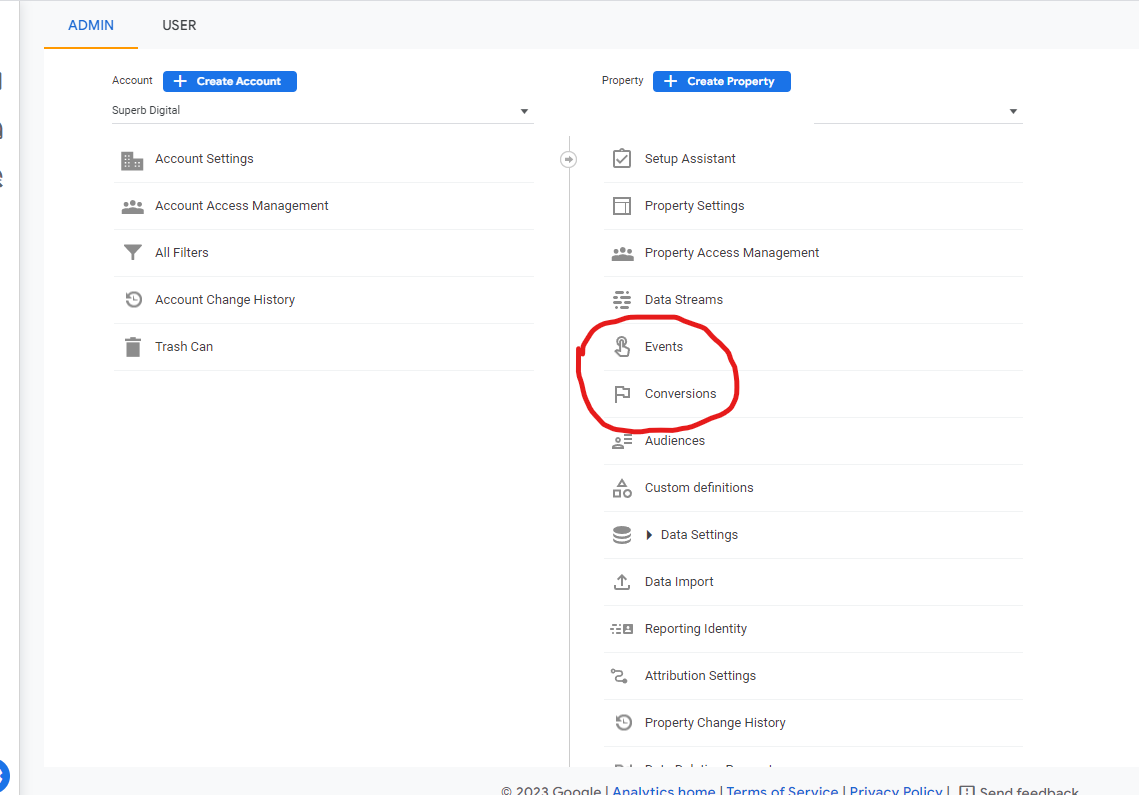
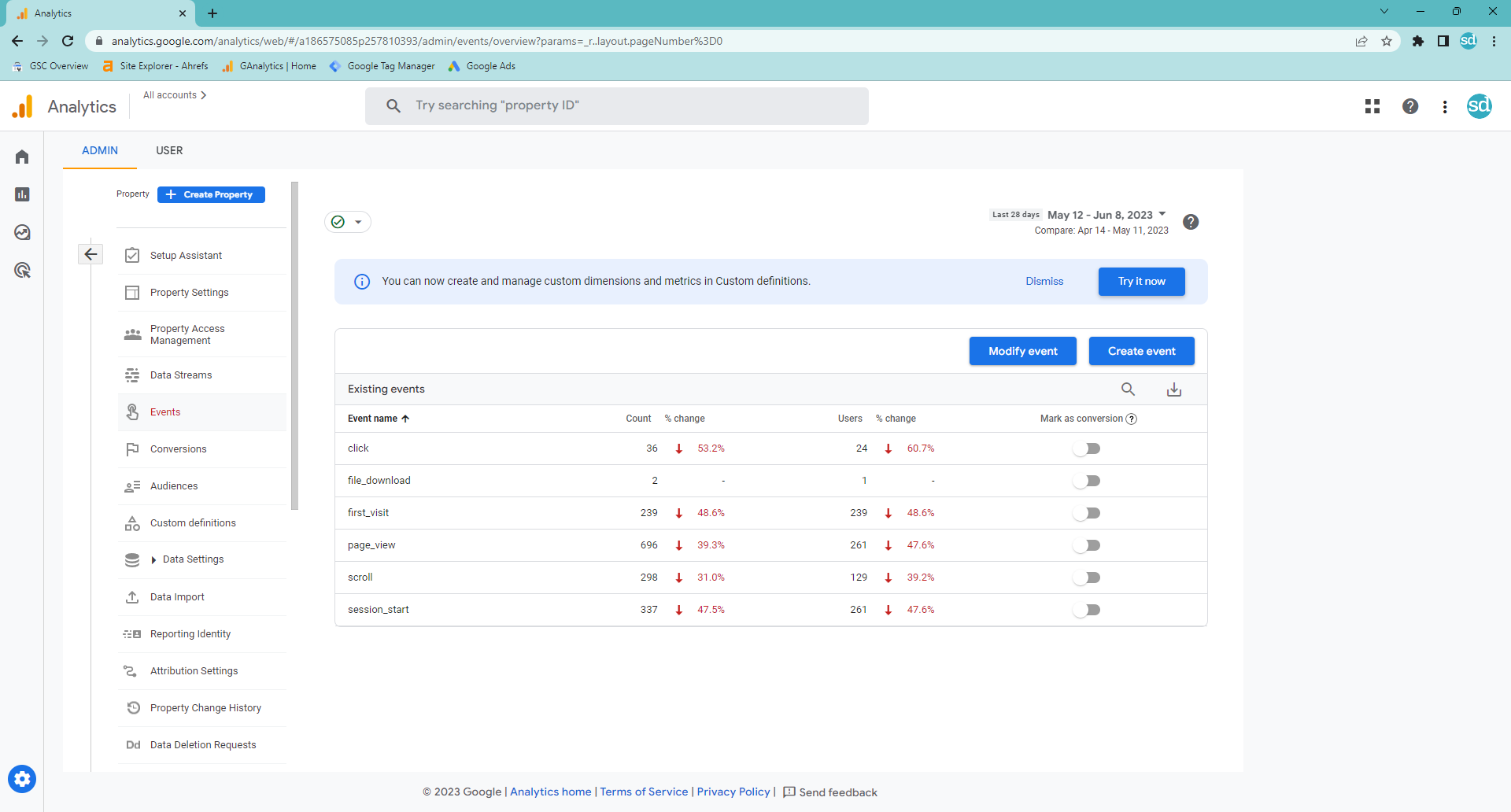
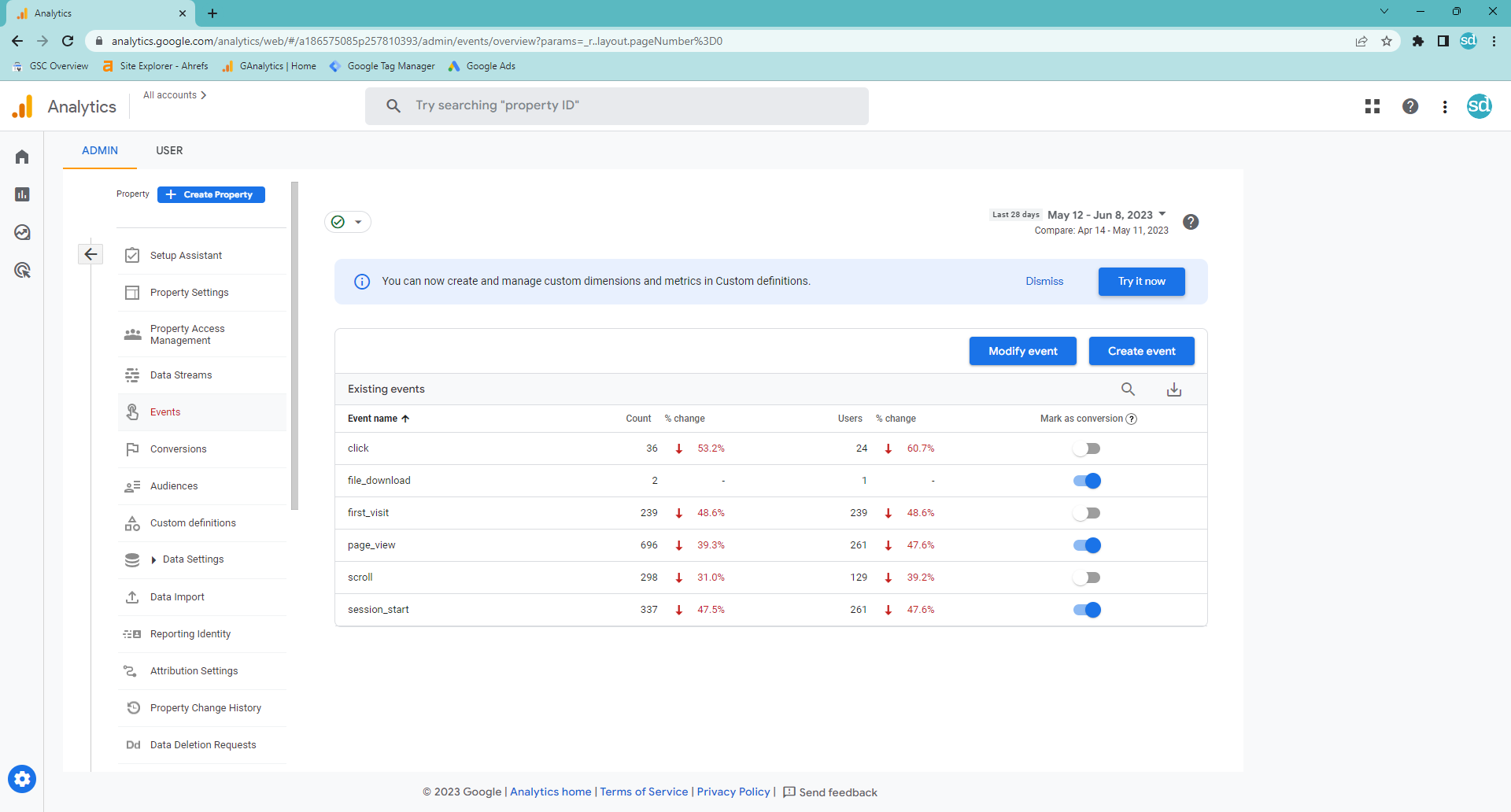
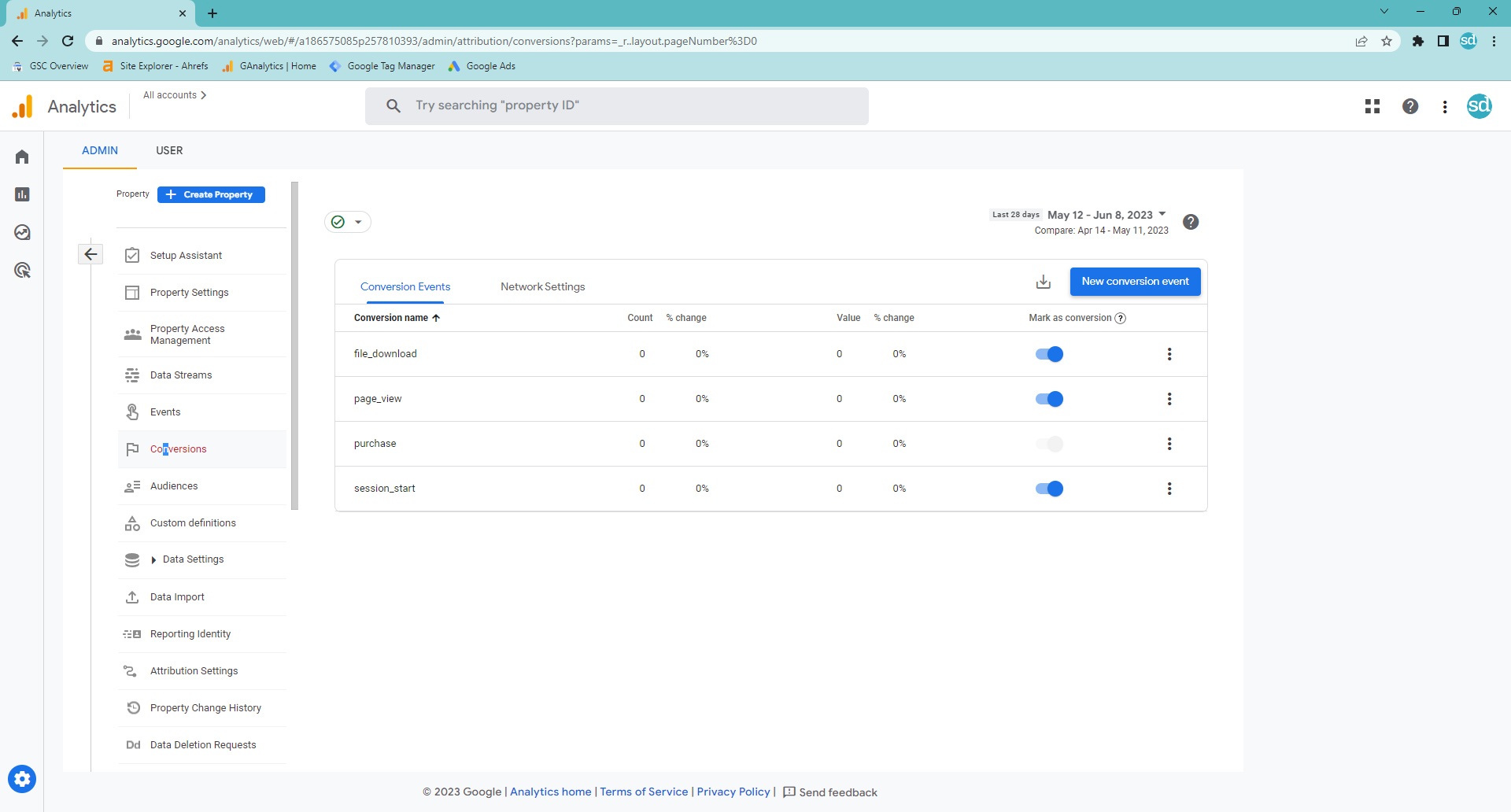
This method works for just tracking the most basic actions, but you won’t necessarily be able to pinpoint which conversions matter the most.
The flexibility of GA4’s conversion tracking capabilities are much more apparent when creating new events from the pre-configured options.
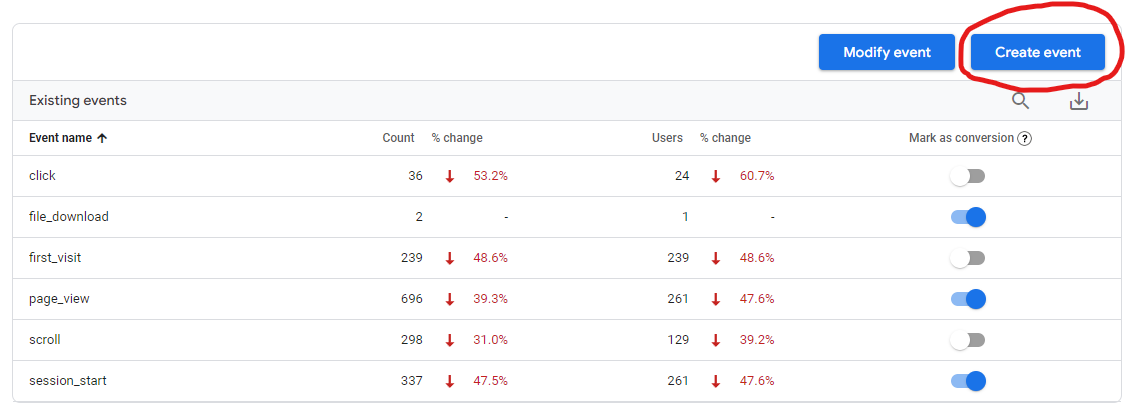
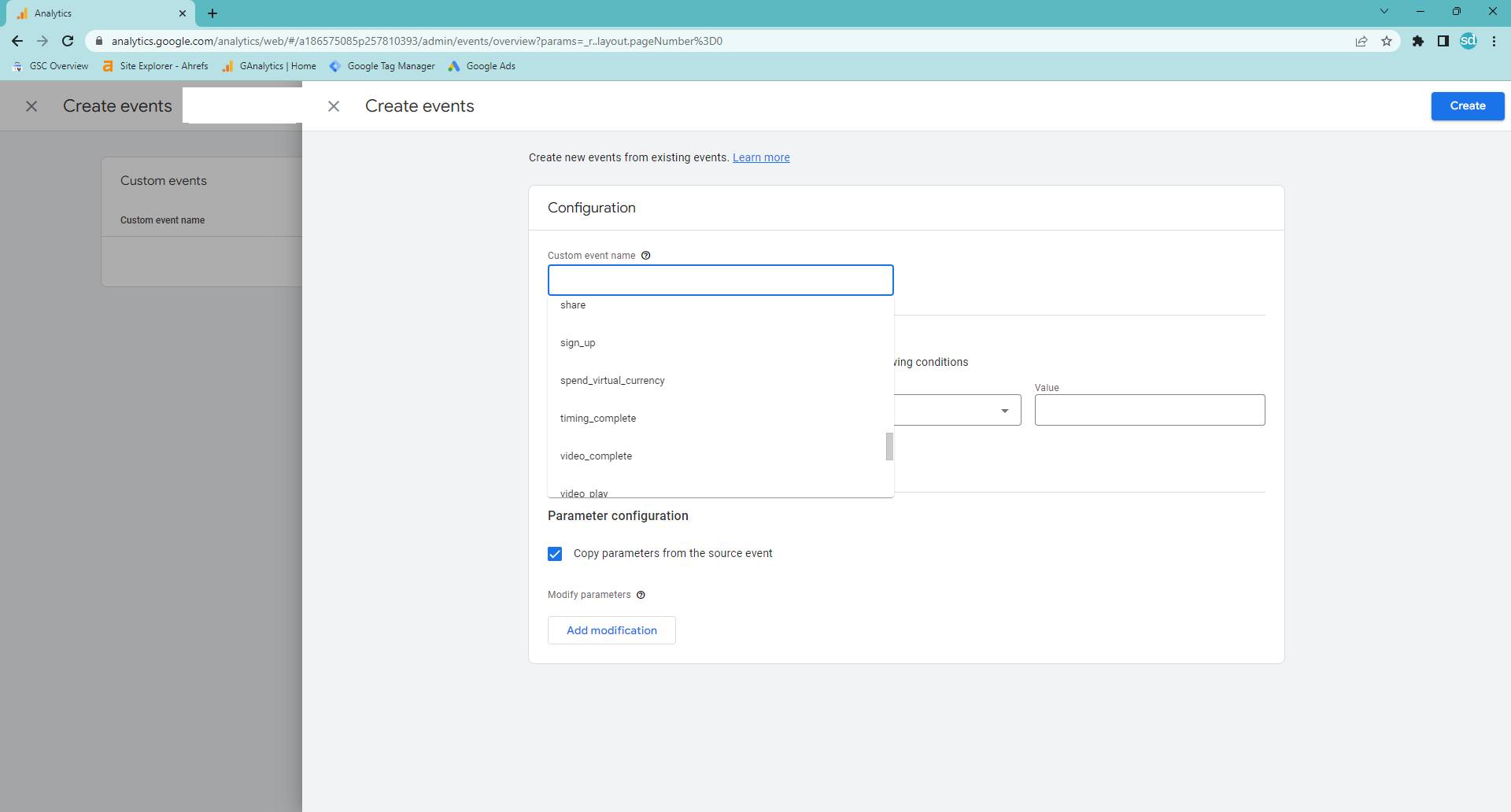
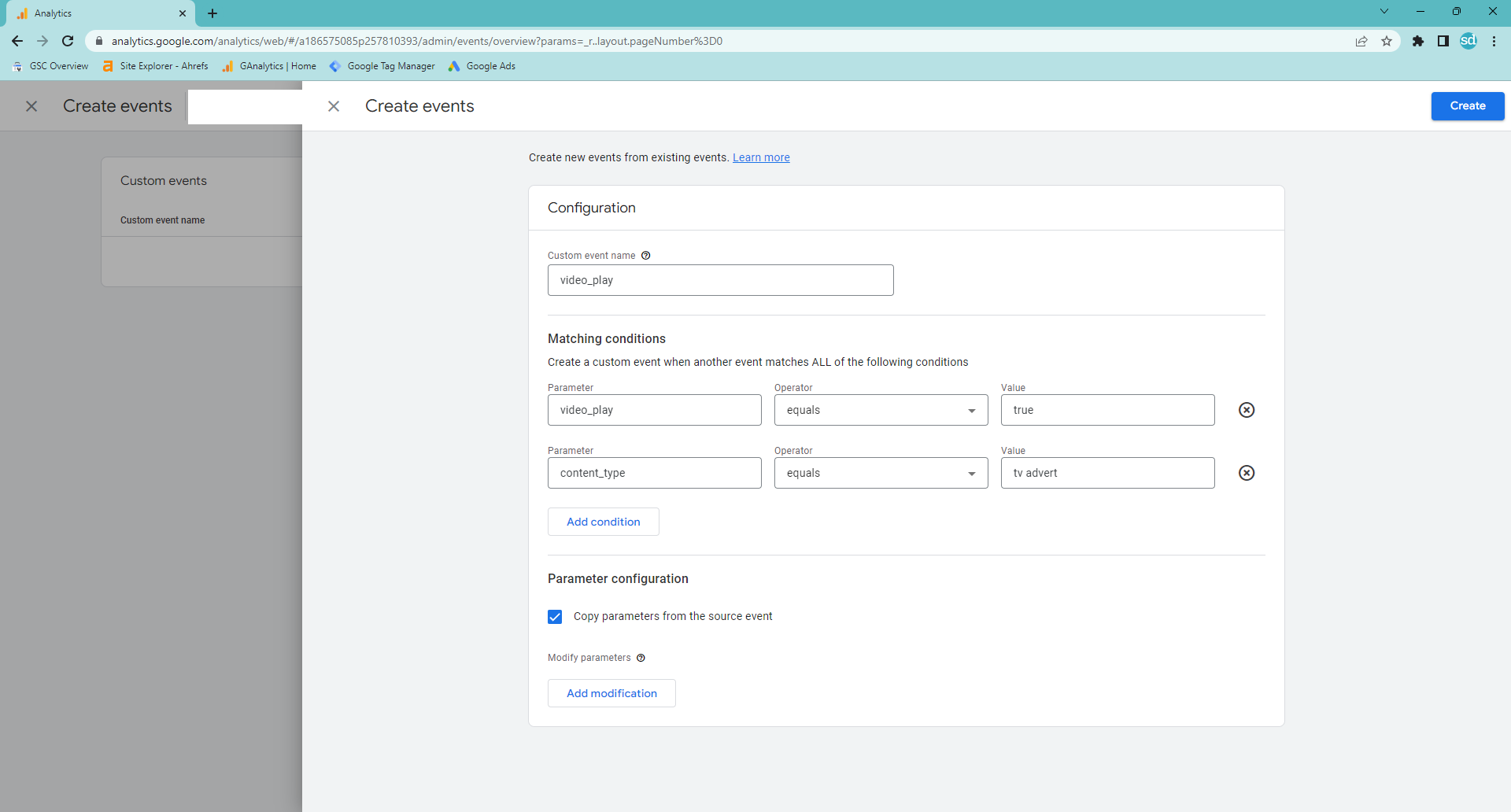
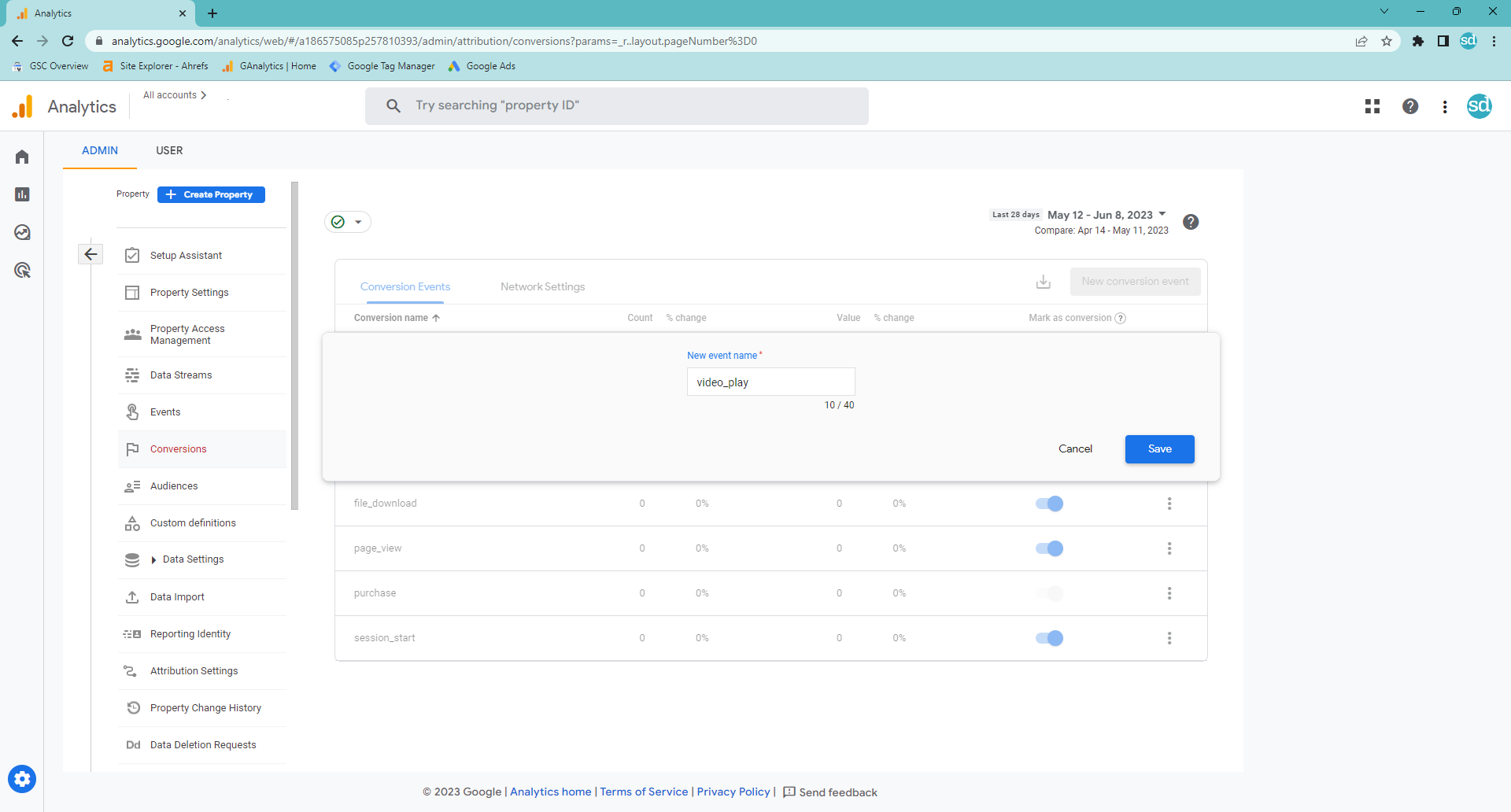
Google Tag Manager is a great companion tool to use with GA4’s dynamic conversion tracking feature.
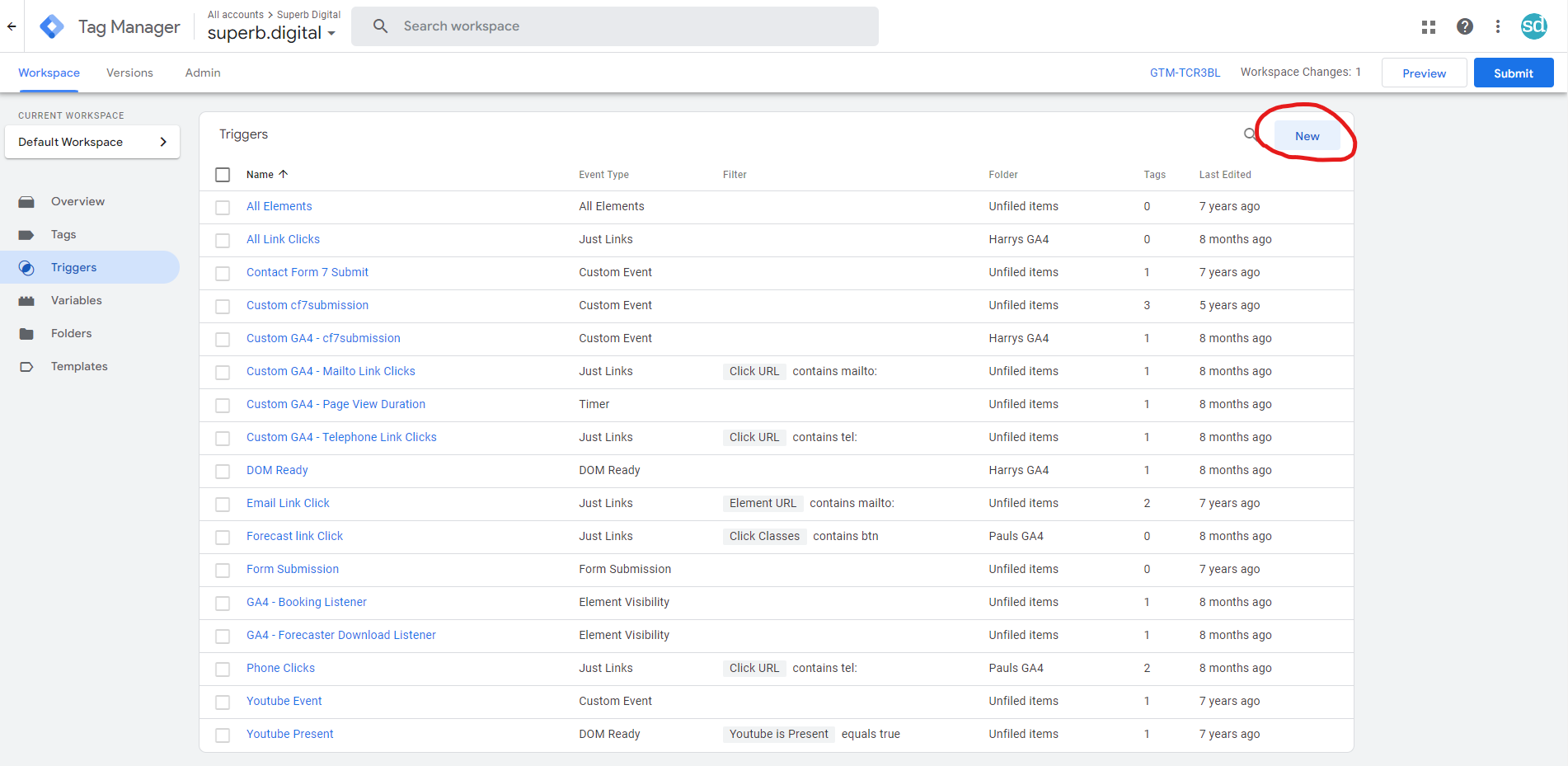
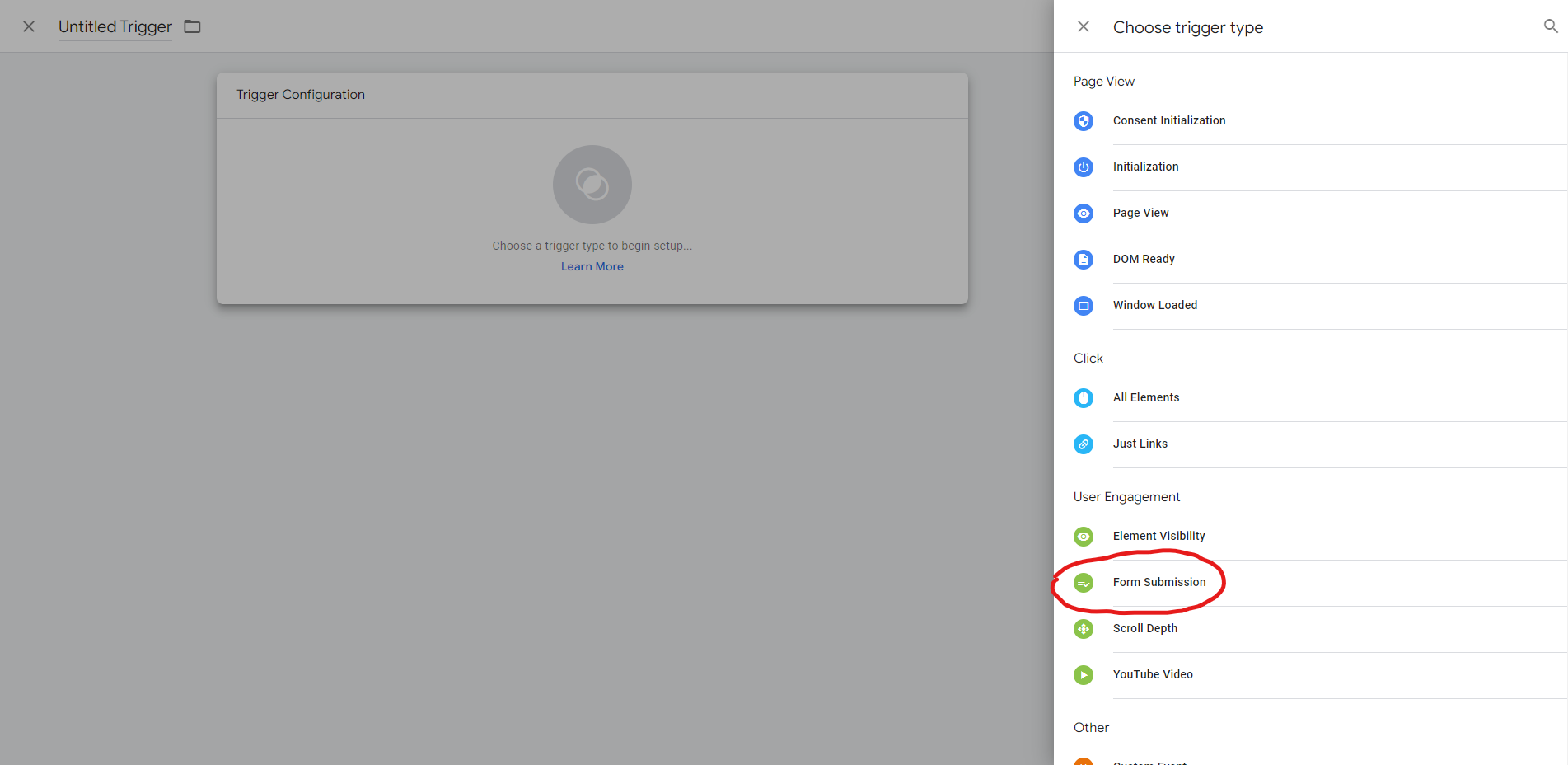





There is a ton of valuable data on all the actions your audience are taking when they get to your website and this information is hugely important. And yet a huge number of businesses have still to set up GA4 and risk all this data disappearing after June.
Setting up Google Analytics 4 isn’t always straightforward so if you’re still having issues after reading this guide, then it might be time to get in touch with the experts.
At Superb, our SEO team are GA4 experts, with a lot of experience migrating our clients and their goals and conversion tracking into this new world. We have the knowledge to not only ensure consistency in your website analytics but also in leveraging so much of the exciting new functionality available in Google Analytics 4 to create even more insights and business intelligence for your business.
Book a call today and I can walk you through our process.
The complex world of greenwashing has been a hot topic in recent years. But in case you’ve missed it, it’s the practice of making products or companies appear more environmentally friendly than they actually are. In a recent interview with Spanish publication ElDiario, we explored the nuances of greenwashing regulations, the accountability of advertising agencies, and the impact of green marketing.
Distinguishing between greenwashing and green marketing is crucial when it comes to understanding the true impact of both. Green marketing involves genuinely connecting eco-friendly brands with like-minded consumers, without the need for deception. While greenwashing attempts to exaggerate environmental claims, regulations emphasizing transparency and honesty still apply to green marketing.
One of the main challenges faced by green marketing today is the erosion of trust due to past greenwashing incidents. Consumers have become understandably skeptical about environmental claims, making it difficult for genuinely eco-conscious brands to gain credibility.
When it comes to determining what constitutes greenwashing, the existing regulations, such as the Green Code by CMA and ASA, seem to leave little room for ambiguity. The guidelines in place provide a clear framework for evaluating the legitimacy of environmental claims.
So the perplexing question is, why does greenwashing continue to persist despite the clarity of these regulations? In many cases, brands that engage in greenwashing are more preoccupied with finding ways to find a way around the guidelines than with adhering to them. Some smaller companies, on the other hand, may not even be aware of the regulatory landscape.
Now, there are also questions about whether these regulations stifle creativity in advertising. While they may impose limitations on certain claims, they should not be perceived as adversaries of creativity. Creativity should be harnessed to tell a brand’s story authentically without resorting to misleading or deceptive practices.
Currently, the fallout from greenwashing typically impacts brands more severely than advertising agencies. Even when high-profile cases of greenwashing are exposed, the agencies involved often escape the brunt of public scrutiny. The repercussions tend to be more detrimental to the brand’s reputation.
However, there is a compelling argument to suggest that advertising agencies should take some responsibility for their involvement in greenwashing campaigns. They should be accountable for conducting thorough research and requesting substantiated evidence for any environmental claims made by the brands they represent. Transparency should be a mutual commitment between brands and agencies, as advertisers cannot afford to blindly accept assertions.
The question of whether blacklisting or shaming advertising agencies that facilitate greenwashing is ethically justifiable remains contentious. While we hesitate to endorse “blacklisting,” we believe that exposing greenwashing, especially in contexts such as the fossil fuel industry, serves a vital purpose. If this exposure motivates agencies to act more responsibly, it could be a necessary step toward ethical advertising practices.
It’s important to note that while stricter regulations can certainly act as a deterrent, they may not eradicate greenwashing entirely. Brands determined to appear “greener” than they are will continue to seek ways around regulations. Recent controversies, such as Shein’s fabrication of a fake factory to deceive influencers and their followers, highlight the extent to which some brands are willing to go to maintain a facade of environmental responsibility.
In conclusion, greenwashing remains a complex issue in the realm of marketing and advertising. While regulations play a critical role in curbing deceptive practices, the responsibility to uphold transparency and authenticity falls on both brands and advertising agencies alike. The challenge lies in bridging the gap between appearance and reality while fostering a culture of genuine environmental responsibility in the marketing world and beyond.
Ever heard of the dark funnel? You’d be forgiven for thinking it sounds like a Jim Henson film or a Stranger Things rip-off. But it’s not as scary or mysterious as it sounds.
It’s no secret that marketers love data. We pore over numbers, analytics, and reports to build the most accurate picture of performance and inform our all-important marketing strategy.
This data is gathered from an array of sources, whether it’s a company’s website, paid advertisements, third-party businesses like HubSpot, or countless other avenues. In fact, businesses put huge amounts of money into collecting as much data as possible about their audiences.
By having an informed plan, underpinned by data, you’re able to craft a marketing strategy tailored to your audience and optimised to target specific demographics. But what about the touchpoints in a buyer’s journey or the sales funnel that can’t be tracked?
This is what’s known as the dark funnel.
Originally coined by 6Sense, the phrase refers to interactions over the course of the sales funnel that you can’t follow or gather data from. To my fellow data-loving marketers, this might seem like a nightmare. But fear not – you can actually harness the power of the dark funnel to further nurture your leads and open the door to new business opportunities.
View image in original blog here.
But before I get ahead of myself, let’s take a look at some examples of dark funnel data:
The above data points are either incredibly difficult to track, or untraceable altogether. But I think we can all agree any marketing that shares your brand with more people is important. You should also note that the dark funnel doesn’t just consist of these data points – it also includes all of the research a potential buyer may have undertaken during the consideration stage (before converting).
A valid question, indeed – why should this concept matter to you and how does it affect your business?
According to CXL:
“over 80% of a customer journey is spent navigating dark channels”
This staggering figure illustrates the huge potential that can be found in dark funnel marketing. This facet of marketing is largely focused on nurturing your leads.
By nurturing your leads, you can increase brand loyalty with your audience before they’re ready to buy. And as 95% of B2B buyers are not currently in the market to buy, it goes without saying that you still want these buyers primed and ready for when they’re prepping a shortlist.
Another reason to consider dark funnel marketing within your strategy comes from the fact that Google is set to phase out third-party cookies. With this huge shift in data privacy incoming, it’s important that your business doesn’t rely too heavily on tracking them. When these get phased out, you likely won’t have enough data to understand your buyers and measure performance, and you risk losing leads.
“…harness the power of the dark funnel to further nurture your leads and open the door to new business opportunities…”
If the dark funnel was a total mystery when you started reading this blog, that’s exactly why you should embrace it. Many companies aren’t doing this yet, which creates a great opportunity for businesses to set themselves apart from the competition and give their marketing a significant boost.
As previously mentioned, dark funnel marketing is all about nurturing leads without analytics, so that they’ll remember your brand and consider your business when they’re ready to make a buying decision. So how exactly can you get people thinking about, talking about, and considering your business over others?
Consistent organic posting
Putting paid promotion behind your social media posts will undoubtedly help your marketing efforts, but it’s crucial that you don’t underestimate the power of organic posting. This free method of marketing solidifies your brand’s online presence on platforms with millions of users. And it’s not just social media. Posting blogs on your company’s website, for example, is a great way to attract potential leads and build your reputation in the market.
High-quality work
This might seem obvious, but by always striving to meet and exceed client/customer expectations, you give people the best reason to talk about you and take control of your reputation. The quality of your work is a direct representation of your business and its values. By producing top-shelf products or delivering first-class service, you allow your work to speak for itself – and people are far more likely to help you spread the word.
Attending events
This is another great way of boosting your brand awareness and holding space in people’s minds, even without trackable data. By attending events, speaking on panels and growing your personal profile (and encouraging your colleagues to do the same) you start to make those all-important face-to-face connections. These interactions tend to stick in people’s minds far more, giving you a chance to leave a lasting impression.
Using the right channels
There are so many online channels where perfect prospects are talking and interacting (with each other, not your content). If you can enter these spaces without selling, whether it’s getting involved in LinkedIn groups, Facebook pages, or something else entirely, you can take part in your prospect’s conversations. But don’t be tempted to lead with your business or credentials. You can get your brand in front of all the right people, and engage with them to form positive relationships, simply by being your helpful, knowledgeable self.
“…Google is set to phase out third-party cookies. With this huge shift in data privacy incoming, it’s important that your business doesn’t rely too heavily on tracking them…”
Just ask
A highly effective yet often-overlooked way to make the most of dark funnel marketing is to ask your leads how they found out about your business. Plain and simple. You can do this by adding a section on your website’s contact form or a step in your checkout process. Alternatively, you can try reaching out via email. This will give you a really strong sense of which of your dark funnel channels are gaining a response from your audience, and which might need a bit more attention.
Hopefully you’re no longer in the dark about dark funnel marketing or its potential to influence your marketing strategy. Now all that is left is turn ideas into action.
While data can get you so far, there are plenty of ways to get front of mind and build your reputation without a cookie, or a dime.
We’re currently offering free marketing consultations, so if you’d like to find out how your business could discover untapped potential, get in touch at marketing@proctors.co.uk.
You need to load content from reCAPTCHA to submit the form. Please note that doing so will share data with third-party providers.
More InformationNotifications